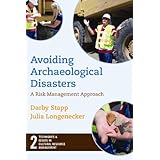
Average Reviews:

(More customer reviews)Anyone thinking about land development -- for agriculture, energy production, housing, mining, golf course construction -- ought to buy and read this book.Any such development runs the risk of encountering "archaeological" (sic; see below) phenomena that can bring the project to a screeching stop at high cost to the project proponent, to say nothing of impacts to the world's cultural heritage itself.Stapp and Longenecker provide a hardheaded discussion of the risks involved in such encounters, and detailed recommendations about how to avoid and manage them.They supplement their work with some very useful appendices, including one that (a remarkable endeavor) summarizes the legal and procedural protections ostensibly extended to "archaeological" resources in virtually every nation in the world."Avoiding Archaeological Disasters" is a resource that every development planner or manager should absorb and keep at hand.
I do have a few quibbles.One is the focus on "archaeological" as opposed to more broadly cultural aspects of the environment that development may affect.The authors acknowledge that it is often non-archaeological issues -- spiritual sanctity, traditional land uses, and the like-- that create the most difficult conflicts with development, but they still make archaeology the lynchpin of their discussion.Most problematically, they recommend getting "archaeological assessments" as the prime means of guarding against disasters.Unfortunately, archaeologists are often ill equipped by training, experience, and disposition to address the full range of cultural issues that may arise to trouble a project; as a result, a merely "archaeological" assessment may systematically misinform planning.
Similarly, the authors rather gloss over the critical question of how one determines that a project even needs some sort of assessment.They refer, for example, to a point in project planning at which "project personnel learn that sensitive resources may be impacted" (p. 57); and say that at this point one should acquire expertise, develop a budget, and so forth.But the critical question of how such personnel are to learn that resources may be affected is not really addressed.Must an "archaeological assessment" be done whenever it's proposed to turn over any ground?Or what?
Finally, in citing guidance that development planners can use to avoid disasters, Stapp and Longenecker miss one of the most creative and helpful (if terribly titled) of the international guidelines -- the "Akwe: Kon Voluntary Guidelines for the Conduct of Cultural, Environmental, and Social Impact Assessments"...(the title goes on and on) issued by the Secretariat of the Convention on Biological Diversity (2004).if every project was planned in accordance with Akwe: Kon, there would be a lot fewer disasters.
That said, however, Stapp and Longenecker have provided an invaluable service in publishing this treatise, and I hope it's widely read and considered by development planners everywhere.
Click Here to see more reviews about: Avoiding Archaeological Disasters: Risk Management for Heritage Professionals (Techniques and Issues Cult Resources Mgmt)
Product Description:
You think it can't happen to you, but it can.One day, months into your construction project, your front end load operator runs into bones and wooden slats. Your county coroner says it is not a crime scene, and refers you to the local archaeology department. The archaeologist tells you that it is a very important discovery. Work stops. Archaeological discoveries happen all the time in the course of projects.Most are manageable, some are less so, and some are mismanaged, wasting time and money.If you are not prepared, the consequences can be disastrous. This book is for project engineers, project managers, construction managers, the staff of affected government agencies, and archaeological consultants. In its pages you receive enough information, enough archaeological perspective, to intelligently work with the various parties involved in your project and avoid an archaeological disaster.
Want to read more honest consumer review about Avoiding Archaeological Disasters: Risk Management for Heritage Professionals (Techniques and Issues Cult Resources Mgmt) now ?

0 comments:
Post a Comment